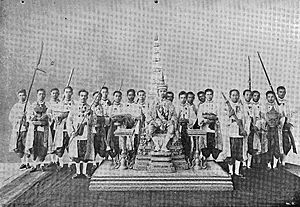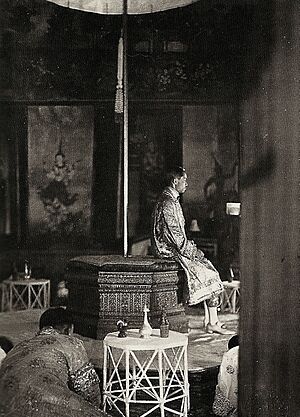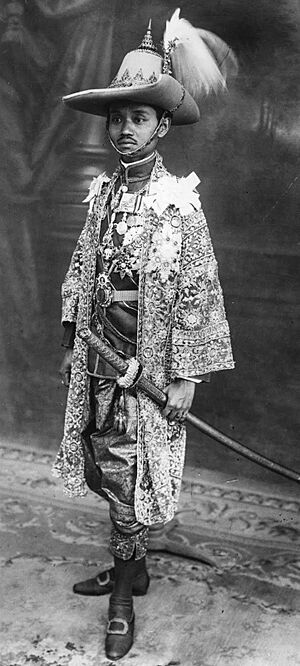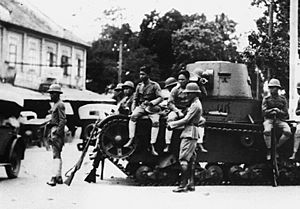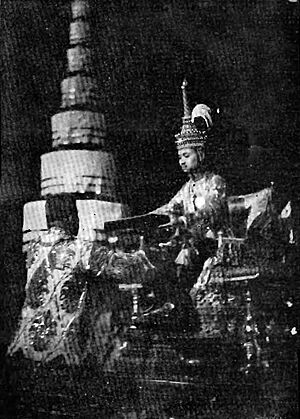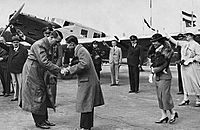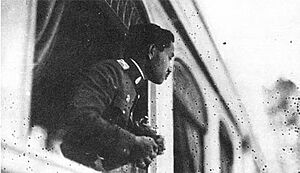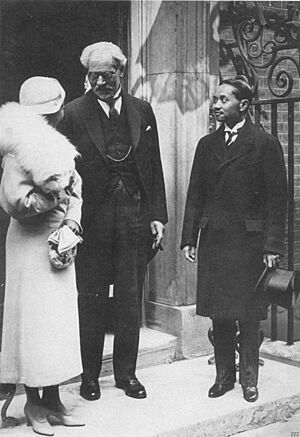Prajadhipok facts for kids
Quick facts for kids Prajadhipokประชาธิปก |
|
|---|---|
| King Rama VII | |
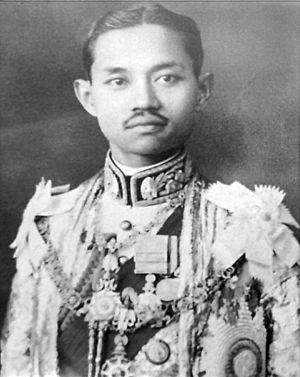 |
|
| King of Siam | |
| Reign | 25 November 1925 – 2 March 1935 |
| Coronation | 25 February 1926 |
| Predecessor | Vajiravudh (Rama VI) |
| Successor | Ananda Mahidol (Rama VIII) |
| Prime Ministers |
See list
Phraya Manopakorn Nititada
Phot Phahonyothin |
| Born | 8 November 1893 Bangkok, Siam |
| Died | 30 May 1941 (aged 47) Surrey, England, United Kingdom |
| Burial | 3 June 1941 Golders Green Crematorium, London, England |
| Spouse | Rambai Barni |
| House | Chakri Dynasty |
| Father | Chulalongkorn (Rama V) |
| Mother | Saovabha Phongsri |
| Religion | Buddhism |
| Signature |  |
| Prajadhipok | |
|---|---|
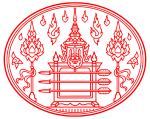
Privy Seal
|
|
| Thai name | |
| Thai | พระบาทสมเด็จพระปกเกล้าเจ้าอยู่หัว |
| RTGS | Prachathipok |
Prajadhipok (Thai: ประชาธิปก; RTGS: Prachathipok; 8 November 1893 – 30 May 1941), also known as Rama VII, was the seventh king of Siam. He belonged to the Chakri dynasty. His time as king was very busy and full of changes for Siam. This was mainly because of the Revolution of 1932. He is the only king from the Chakri Dynasty to ever give up his throne.
Contents
Prajadhipok's Early Life
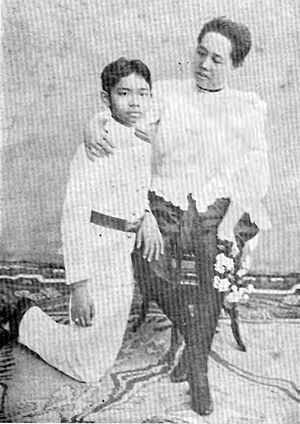
Prince Prajadhipok Sakdidej was born on November 8, 1893, in Bangkok, Siam. His parents were King Chulalongkorn and Queen Saovabha Phongsri. He was the youngest of their nine children. Overall, he was the king's second-youngest child out of 77 children.
Since he was not likely to become king, Prince Prajadhipok decided to join the military. Like many royal children, he went to study abroad. He attended Eton College in England in 1906. Then, he went to the Woolwich Military Academy and finished in 1913. He became an officer in the Royal Horse Artillery in the British Army.
In 1910, King Chulalongkorn died. Prajadhipok's older brother, Vajiravudh, became King Rama VI. When World War I started, King Vajiravudh told his younger brother to leave the British Army. He had to return to Siam right away. This was hard for the prince, who wanted to fight in the war. Back home, Prajadhipok became a high-ranking military officer in Siam. In 1917, he became a monk for a short time, which was a common tradition for Buddhist men in Siam.
In August 1918, Prince Prajadhipok married his cousin and childhood friend, Rambhai Barni. She was a descendant of King Mongkut, Prajadhipok's grandfather. They got married at Sukhothai Palace, which was a gift from Queen Saovabha Phongsri.
After the war in Europe, he studied at the École Superieure de Guerre in France. He then returned to Siam and continued his military career. During this time, he received the special title Krom Luang Sukhothai. Prajadhipok and his wife lived a quiet life at Sukhothai Palace. They did not have any children.
Prajadhipok quickly moved up in the line to the throne. This happened because his older brothers all passed away within a short time. In 1925, King Vajiravudh died at age 44. Prajadhipok became the absolute ruler when he was only 32 years old. He was crowned King of Siam on February 25, 1926.
Becoming King: A Time of Change
Prajadhipok was not fully ready to be king. But he was smart, polite, humble, and eager to learn. However, he inherited big problems from the previous king. Siam was facing money troubles, and the royal finances were a mess. The whole world was also going through the Great Depression, which made things even harder.
To help fix things, Prajadhipok created the Supreme Council of the State of Siam. This council had five experienced members of the royal family. These members had not been close to the previous king. The council included three of his uncles and two of his half-brothers.
Many of these princes felt it was their job to fix the mistakes of the past. But people did not always understand their actions. The government did not explain why they were cutting spending. Slowly, these princes gained more power. They took over important government jobs. They also gave jobs to their sons and brothers. By April 1926, most government leaders were replaced by princes or nobles. While this brought back skilled people, it also meant the royal family had too much power again.
The king wanted to show a clear change from the previous reign. He chose people who he thought would help bring back a good government. Unlike the king before him, Prajadhipok read almost all government papers. He read everything from official reports to letters from citizens. The king was careful and hardworking. He would ask many experts for their ideas. He would study their suggestions carefully. But sometimes, he found it hard to choose the best option. He often relied on the Supreme Council to help him decide.
From the start of his rule, King Prajadhipok knew that political changes were needed. He saw his new Supreme Council as a way to limit the power of an absolute monarch. In 1926, Prajadhipok tried using the Privy Council as a law-making group. This council had over 200 members. But it was too big and slow. So, in 1927, Prajadhipok created a smaller Committee of the Privy Council. This committee had 40 members chosen from the royal family or nobles. The newspapers liked this idea. They saw it as a step towards a parliament or National Assembly. But in reality, the committee did not become very powerful.
In 1926, Prajadhipok wrote a long letter to his American advisor, Francis B. Sayre. In it, he listed nine big problems facing Siam. He wondered if Siam should have a parliament. He also asked if Siam was ready for a government where people elected their leaders. He strongly felt that Siam was not ready for that yet.
However, the king did think about making changes at the local level. He saw this as a way to teach people about democracy. In 1926, he started to develop the idea of "municipality" or local self-government. This idea had started earlier as a law about public health. They gathered information about how other countries managed local government. They even made plans to let some towns collect their own taxes and manage their own money. But people were not educated enough for this plan to work well. Still, the idea of teaching Siamese people about democracy through local power became important to Prajadhipok.
In September 1931, Britain stopped using the gold standard. This made their money worth less. This caused a problem for Siam because most of its foreign money was in British currency. The Minister of Finance kept Siam on the gold standard by linking its money to the US dollar. But there was a lot of debate about this decision. One effect was that Siam's rice exports became more expensive. This hurt the country's income.
In October 1931, the king came back from a trip. He asked his Foreign Minister to prepare a constitution. This document was drafted by an American, Raymond B. Stevens, and Phaya Sri Wisarn Waja. In March 1932, they gave the king their plan for changes in government. Prajadhipok originally planned to announce the new constitution on April 6. This was for the 150th anniversary of the Chakri dynasty. But other royal family members strongly disagreed. Even though the king worried about a coup, he did not make the announcement.
On January 20, 1932, the country was in a deep economic crisis. The king held a meeting to discuss how to fix it. They agreed to make big cuts in government spending. Two weeks later, on February 5, the king spoke to military officers. He talked a lot about the economy. He said, "I myself know nothing at all about managing finances... If I have made a mistake, I believe I really deserve to be excused by the people of Siam." No king before him had ever spoken so openly. Many people saw his words as a sign of weakness. They thought it proved that the system of absolute rule should end.
The Big Change: 1932 Revolution
A small group of soldiers and government workers secretly planned to end the absolute monarchy. They wanted to create a government with a constitution. Their plan happened on June 24, 1932. It was a peaceful "revolution" by a group called the Khana Ratsadon (People's Party).
King Prajadhipok was away at his palace in Hua Hin. The plotters took control of the Ananda Samakhom Throne Hall in Bangkok. They arrested important officials, mostly princes and the king's relatives. The People's Party demanded that Prajadhipok become a constitutional monarch. This meant he would still be king, but his power would be limited by a constitution. They also demanded that Thai people be given a constitution. If he said no, they would declare Siam a republic. The king quickly agreed to their demands. The first "permanent" constitution of Siam was put into effect on December 10.
Prajadhipok returned to Bangkok on June 26. He met with the coup leaders. When they entered the room, Prajadhipok stood up and greeted them. He said, "I rise in honour of the Khana Ratsadorn." This was a very important gesture. Kings usually stayed seated while their subjects bowed to them. Prajadhipok was showing that things had changed. Absolute monarchy was over.
King Under a New System
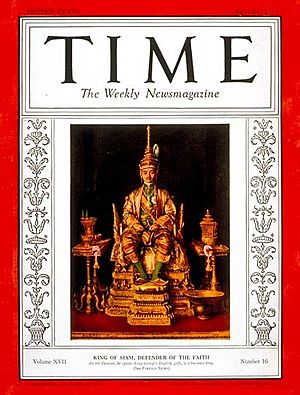
At first, the King and the royal family seemed to get along with the Khana Ratsadon. The first constitution was meant to be temporary. The new constitution gave back some of the king's power and status. For example, half of the House of Representatives would not be elected. Also, the king would have the power to reject laws. The country's first prime minister, Phraya Manopakorn Nititada, was a traditional nobleman.
But the agreement soon broke down. The king did not argue when his ideas about an economic plan were released with his signature. This plan included land reform and taking royal land. The King played a part in a coup in April 1933. The Prime Minister ordered the House to close. The King signed an order to punish Khana Ratsadon leaders. But the military leader of Khana Ratsadon, Phraya Phahol Phonphayuhasena, then removed the government and brought back the People's Party's power.
In October 1933, Prince Boworadej, a former defense minister, led an armed rebellion against the government. In the Boworadet Rebellion, he gathered soldiers from different areas. He marched them to Bangkok and took over the Don Muang airport. Prince Boworadej said the government was disrespectful to the king. He also accused them of promoting communism. He demanded that government leaders resign. But the rebellion eventually failed.
The King did not directly support the rebellion. When the revolt began, Prajadhipok told the government he was sorry for the trouble. The King and Queen then went to Songkhla in the south for safety. The Khana Ratsadon saw the king's leaving as a failure to do his duty. By not fully supporting the government forces, he lost their trust.
In 1934, the Assembly voted to change some laws. The King disagreed with some changes. He also protested a change that would lessen the king's power over death sentences. After many disagreements with Khana Ratsadon, the King seemed to change his mind. He said he supported democracy. But he also blamed Khana Ratsadon for being against democracy.
Prajadhipok's relationship with the Khana Ratsadon had been getting worse. He went on a trip to Europe and then to England for medical treatment. He kept talking with the government about the conditions for him to remain king. He wanted to keep some royal powers, like the power to reject laws without anyone being able to overrule him. There were also disagreements about royal money and benefits. Since the government did not agree, Prajadhipok announced on October 14 that he would give up his throne unless his requests were met.
A Trip to Europe
-
King Prajadhipok and Adolf Hitler in Nazi Germany, 1934
-
King Prajadhipok and Queen Rambhai Barni with Konstantin von Neurath in Nazi Germany, 1934
Giving Up the Throne
The People's Party rejected the king's demands. So, on March 2, 1935, Prajadhipok gave up his throne. Ananda Mahidol became the new king. Prajadhipok released a short statement criticizing the government. He said:
I am willing to surrender the powers I formerly exercised to the people as a whole, but I am not willing to turn them over to any individual or any group to use in an autocratic manner without heeding the voice of the people.
The former king had good reasons for his complaints. People noted that the absolute power of the monarchy had been replaced by the absolute power of the People's Party. The military was waiting in the background as the final decision-maker.
Life After Being King
Prajadhipok spent the rest of his life with Queen Rambhai Barni in England. After he gave up the throne, they lived at Knowle House in Surrey, near London. But this house was not good for his health. So, they moved to a smaller house called "Hangmoor" in Virginia Water, Surrey. He renamed it "Glen Pammant." They stayed there for two years. The couple did not have their own children. But they adopted the youngest son of Prince Bhanurangsi Savangwongse.
Their adopted son, Prince Suprabhat Chirasakti, later became a pilot in Britain during World War II. He died in a plane crash on September 12, 1942. His funeral was held in London. Queen Rambhai Barni and a few close relatives attended.
The royal couple moved again to Vane Court, an old house in Biddenden, Kent. He lived a peaceful life there. He enjoyed gardening in the mornings and writing his autobiography in the afternoons.
In 1938, the royal couple moved to Compton House in Wentworth, Surrey.
Because of bombing by German planes in 1940, they moved again. First, they went to a small house in Devon. Then, they moved to Lake Vyrnwy Hotel in Powys, Wales. There, the former king had a heart attack.
The couple returned to Compton House because he wanted to die there. King Prajadhipok passed away from heart failure on May 30, 1941.
His body was cremated at the Golders Green Crematorium in London. It was a small ceremony with only Queen Ramphai and a few close family members. Queen Ramphaiphanni stayed at Compton House for eight more years. She returned to Thailand in 1949, bringing the king's ashes with her.
What Prajadhipok is Remembered For
Prajadhipok is remembered as a hardworking and effective leader. He was smart and good at his job. His main challenge was that he did not fully understand how much the people in Bangkok wanted more power. Even after his death, many people agreed that the move towards democracy in 1932 was too soon.
Honoring Prajadhipok
-
A Statue of the king in Sukhothai Thammathirat Open University, Nonthaburi
| Monarchs of the Chakri dynasty |
|
|---|---|
| Phra Buddha Yodfa Chulaloke (Rama I) |
|
| Phra Buddha Loetla Nabhalai (Rama II) |
|
| Nangklao (Rama III) |
|
| Mongkut (Rama IV) |
|
| Chulalongkorn (Rama V) |
|
| Vajiravudh (Rama VI) |
|
| Prajadhipok (Rama VII) |
|
| Ananda Mahidol (Rama VIII) |
|
| Bhumibol Adulyadej (Rama IX) |
|
| Vajiralongkorn (Rama X) |
|
Military Ranks
Awards from Other Countries
 Denmark Order of the Elephant, Knight, February 8, 1926 (Denmark)
Denmark Order of the Elephant, Knight, February 8, 1926 (Denmark) Italy Order of the Annunciation, Knight (Kingdom of Italy)
Italy Order of the Annunciation, Knight (Kingdom of Italy) Belgium Royal Order of Leopold, Grand Cordon, 1926 (Belgium)
Belgium Royal Order of Leopold, Grand Cordon, 1926 (Belgium)
Images for kids
-
King Rama VII and Queen Rambhai Barni after meeting Pope Pius XI at Vatican City, 1934
See also
 In Spanish: Prajadhipok para niños
In Spanish: Prajadhipok para niños


